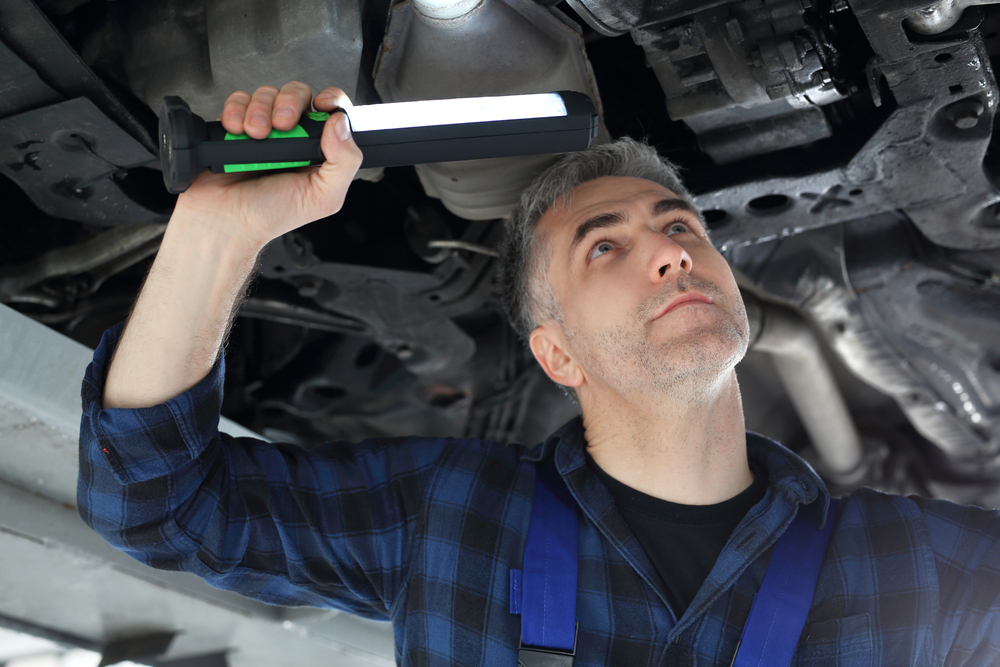How to perform a Pre-Purchase used vehicle inspection?
Valerie Raskovic
Sep 11, 2024
Buying a pre-owned vehicle can be an exciting and at the same time a daunting experience. The act of buying a pre-owned vehicle involves a fair bit of risk. It is important to help minimize the chances of getting a bad apple by performing a pre purchase vehicle inspection. A Pre-Purchase Vehicle inspection is one of the most important steps you should take before making your purchase decision. This process helps identify possibly hidden issues that could lead to costly repairs down the road.
In this article we have outlined all the steps you will need to follow to conduct a proper pre-purchase used vehicle inspection. We did our best to ensure that the instructions are straight forward however, If you do not feel comfortable tackling any of the steps outlined in the guide below we highly suggest that you seek the help of an independent automotive technician or a vehicle inspection expert.
1. Preliminary Research
The first step begins before you even come to view the car in person. Preliminary research of a certain year, make and model vehicle will allow you to understand the vehicle’s shortcomings and what to look for during the actual inspection. Many vehicles have existing faults that used car buyers should look out for. For example, certain years and models of Subarus are known for having head gasket failures which could lead to extensive and costly repairs. Knowing this information is valuable because basic research into this subject should give you the knowledge you will need to identify all the tell-tale signs of head gasket failure or you can choose to avoid those specific vehicles entirely. This preliminary research will help you identify any potential red flags even before the physical inspection begins.
In addition to researching the vehicle by year make and model it is highly advised to research the vehicle’s history by running a full vehicle history report. This report may aid in identifying past damage, accidents, title issues and potential recalls. Cars with a history of accidents are more likely to incur higher than average future repair costs so it is important to know what you are getting into before committing to go inspect the vehicle in person. Also, vehicles with a salvage history and accidents tend to have a lower resale value thus are deemed less desirable. The report may also help identify other red flags like odometer fraud or salvage titles.
One final bit of online research we suggest is to research the vehicle’s average market pricing. Go to multiple automotive marketplaces to shop the same year, make and model vehicle with similar mileage. This will give you a better understanding of the real fair market price of the vehicle you may be interested in purchasing. In short, knowing what the car is worth can help you get a fair deal.
2. Inspect the Vehicle's Exterior
When inspecting the car in person, do not rush. Always insist that the car is presented during the day in the sun light or in a well-lit area. Start by carefully examining the vehicles exterior. Look for any signs of body damage, rust, or repainting. Body damage can sometimes be concealed under layers of body filler and paint, making it harder to spot. To catch signs of previous repairs, it's helpful to examine the paint from an angle rather than directly head-on. This will make it easier to notice any inconsistencies or imperfections.
Things to look for:
- Body Panels: Check wavey panels, the paint will look uneven and may not have a consistent finish. Check for uneven panel gaps. Keep in mind the distance between the panels should be the same on one side of the car as the other. Check for scratches under the paint work, and mismatched paint, which may indicate past bodywork. Run your fingers on the inner portion of the door, feel for any cut marks or hard ridges in the paint. This may suggest a previous paint job where the new paint blends with the original. Check all sides of the car from all angles with the sun towards your back to check for any mismatched paint or blend marks.
- Check all weather seals and trim: Inspect window seals for cracking and dry rot. Keep an eye out for paint cut marks hidden just below some of the trim.
- Tires: First thing make sure all tires are the same size and preferable the same brand and tread type. Inspect each tires condition by looking for any dry rot cracking and uneven wear patterns. Measure the tire tread depth using a tire depth gauge, making sure that none of the tires drop below 2/32 on an inch in tread depth. Any tire with a reading below that measurement will require replacement.
- Windows and Mirrors: Look for cracks or chips in the glass. Ensure mirrors are intact and properly aligned.
- Lights: Check headlights, taillights, and turn signals for functionality and damage. It is not uncommon for plastic headlights to become dull and discolored over the years. We do not consider this a deal killer as it is easily rectified with some sanding and polishing.
3. Examine the Interior
Once you’ve finished inspecting the outside, move to the interior. As done with the exterior inspection make sure the car is located in a well-lit area.
Things to look for:
- Seats and Upholstery: Look for tears, stains, or excessive wear on the seats and carpets.
- Dashboard and Controls: It is absolutely vital that you test all dashboard controls, including the air conditioning, radio, and dashboard warning lights.
- Odometer: Confirm the mileage on the odometer aligns with the seller’s claims in the for-sale listing. Not all high mileage vehicles are doomed for higher-than-average repairs, generally it dependents on how well the vehicle was maintained and cared for by the previous owners. However, as a general rule excessively high mileage on a vehicle typically will indicate that it has had more wear and tear and may not have as long of a life span left as a similar car with lower mileage.
- Smell: Look for any unusual smells like indicative of cigarette smoke. In most cases you can get cigarette smoke smell out of an interior however, a musty smell or one of rotten eggs can be an indicator of something far more serious. A smell of rotten eggs could be an indicator of transmission issues. A musty smell could indicate water damage or potential leaks.
- Check gauge cluster: When the engine is running check the vehicle gauge cluster for any warning messages. Some disingenuous sellers have been known to temporarily reset the engine computer causing the warning messages to temporarily go away. For this it may help to scan the vehicle using an OBD2 scanner. If you do not have this tool or are not familiar with how to use it, most car part stores like AutoZone and O’Reilly’s carry it and will scan the car free of charge in most cases.
4. Inspect Under the Hood
Pop the hood and inspect the engine bay for signs of neglect or damage. Here are some components to focus on:
- Fluids: Check the top of the car for signs of fluid leaks also check under the car. When possible, check oil, transmission fluid, coolant, and brake fluid levels. Look for leaks or dirty fluids that could suggest neglect or mechanical issues. With the car in the off position and cold, open the radiator coolant overflow canister, check for any signs of oil. Oil mixed in the coolant could be an indicator of very serious engine problems such as head gasket damage and engine cracks.
The engine oil may help identify some catastrophic engine issues so spending some time examining it may help you avoid serious issues and possible engine replacement in the long run. Check the engine oil. If it appears gooey, have a milky texture it may be another indicator of critical structural engine issues causing the coolant to mix with the oil. Check the oil for any shiny flakes or metal particles as that is also a sign of possible catastrophic engine failure. Check the oil cap for strong smell of gasoline, that can be an indicator of internal engine issues.
If the vehicle is equipped with an automatic transmission and if it has a transmission fluid dipstick, pull it out and check the color. Most Automatic Transmission Fluids (ATF) are red in color so if it appears completely black, or smells burnt it is a sign of excessive wear or internal transmission damage.
- Wires: Check for any frayed, loose or damaged wires. Damaged wiring can be an indicator of rodent related damage or electrical system degradation.
- Structural Damage: Check for any metal buckles, unusual bends, paint discoloration in the metal structural components like the core support frame rails and apron.
- Check the Air Filter: Open the air box and check if the air filter is dirty. A very dirty air filter can be an indicator of overall neglect by the previous owner.
- Check for excessive corrosion: It is vital to check for excessive corrosion around the structural portions of the vehicle such as the strut towers and frame rails. Excessive corrosion could highly jeopardize the vehicles safety and value.
- Belts and Hoses: Inspect all the belts and hoses for cracks, fraying or wear. Worn belts and hoses may need immediate replacement. When neglected hoses and belt damage can cause serious damage to the drivetrain.
- Battery: Check the battery terminals for corrosion and ensure the battery is properly secured.
5. Check the Undercarriage
Use a flashlight to inspect the undercarriage of the vehicle. Look for rust or damage to the exhaust system, frame, and suspension components. Pay attention to any leaks coming from the engine, transmission, or differential.
If possible, lift the car using a jack stand and axle stands and wiggle the front wheels up and down and side to side. Any looseness can be an indicator of suspension issues such as ball joint failure, control arm and bushing failure, sway bar link failure and more… This is not a total deal breaker but will need to be rectified in order to make the vehicle road worthy and safe for its occupants.
6. Test Drive the Vehicle
A thorough test drive is crucial to understand the vehicle’s overall condition. During the drive, test the following:
- Cold Start (DO NOT FORGET THIS ONE – IT IS IMPORTANT): Always insist that the seller present the vehicle while the vehicle is cold and has not been driven within the last couple of hours. Starting the vehicle while it is cold will allow you to spot certain issues that may be hidden when the vehicle is fully warmed up. It is common for cold engines to have a bit of a higher idling RPM for up to 30 seconds but it is important to check to make sure it eventually settles down into the normal idle range for that vehicle. Most cars will idle anywhere from 600 to 900RMP anything below or above that for extended prior of time can be an indicator of various problems such as vacuum leaks, throttle body problem, mass air flow and 02 sensor problems and more…
Before getting the car in gear and taking it on a test drive listen to the engine noise. You may need to step on the accelerator while the vehicle in in park or neutral with the parking brake engaged to see how the engine reacts so your input while standing with 0 load. If the RPM does not drop after you let go of the gas peddle or if the RPM drops below 600 or the vehicle stalls, that can be an indicator of possible engine problems. DO NOT over rev the vehicle, just get it up to 3000 to 4,000 RPM, do not take it into the red zone. While the engine is running in the parked position listen for any knocking or unusual sounds. Various sounds can be an indicator of possible engine issues.
- Braking: Ensure the brakes respond smoothly without grinding or pulling to one side. As you brake firmly check for any uneven brake pressure, squealing sounds or vibration coming from the brake pedal. This could be a sign of worn or damaged brake components.
- Acceleration: The engine should respond promptly without hesitation or unusual noises. Check for any unusual smells such as exhaust or gas smoke inside the vehicle while driving.
- Steering: Drive the vehicle on a straight and even road. The steering should feel tight and responsive, with no excessive play or vibrations. Check to see if the steering wheel is off center or if the wheel/vehicle pulls in any direction without your steering it. This could be an indicator of possible suspension and alignment issues. With all of the windows open take a very slow but sharp corner. Check for any rubbing or clunking noise which could be an indicator of various suspension issues. Also, check for any vibrations you may be feeling through the steering wheel.
- Transmission: For an automatic transmission vehicle put the car into all the gears while having the brake pedal firmly depressed. Check for any auditory clunks and hard jerks when going into gear, it should shift smoothly. If manual, the clutch should engage without slipping or grinding while shifting into gear.
7. Get a Professional Inspection
While performing your own inspection is useful, it’s not something everyone will be able to do on their own. It is advisable to have a professional mechanic conduct a more thorough pre-purchase inspection. Professionals can spot hidden issues, such as internal engine or transmission problems, that you might miss. They will also use diagnostic tools to ensure there are no error codes or underlying electronic issues.
8. Negotiate with Confidence
Armed with the findings from your inspection, you can confidently decide to either continue to negotiate with the seller or to walk away. If the inspection reveals any issues, you can use this as leverage to lower the price or ask for repairs before purchasing. Conversely, if the car is in good condition, you can move forward knowing you’ve made an informed decision.
A pre-purchase vehicle inspection is one of the best ways to ensure you’re getting your money’s worth. Taking the time to research and inspect a vehicle thoroughly can save you from unexpected repairs and costs in the future. If you’re unsure of your abilities, consider hiring a professional inspector to ensure you don’t overlook any crucial details.
Read more articles

